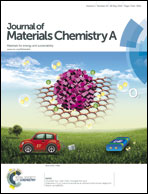Liquid crystalline phase behavior and fiber spinning of cellulose/ionic liquid/halloysite nanotubes dispersions†
Abstract
Highly ordered, homogeneous and enhanced microcrystalline cellulose (MCC)/halloysite nanotubes (HNTs) composite fibers have been successfully prepared from MCC/1-allyl-3-methylimidazolium chloride (AMIMCl)/HNTs dispersions with liquid crystal (LC) phases by a wet-spinning method, and their structures, morphology, mechanical, thermal and water barrier properties were investigated. The results revealed that the dispersions displayed stronger birefringence with increasing HNTs content, and became intensely birefringent when sheared; the birefringence also persisted for minutes after shearing was stopped. Rheological measurements showed that the dispersions had stronger shear thinning behavior. The thermal stability and tensile strength of the cellulose nanocomposite fibers were significantly improved compared with those of the pure MCC fiber. A more significant result is that the addition of HNTs significantly improved the moisture barrier properties of the regenerated MCC fibers. The above findings shed light on the liquid crystal phase behavior of HNTs dispersions and lay the foundation for fabrication of high performance fibers by liquid crystalline spinning.


 Please wait while we load your content...
Please wait while we load your content...